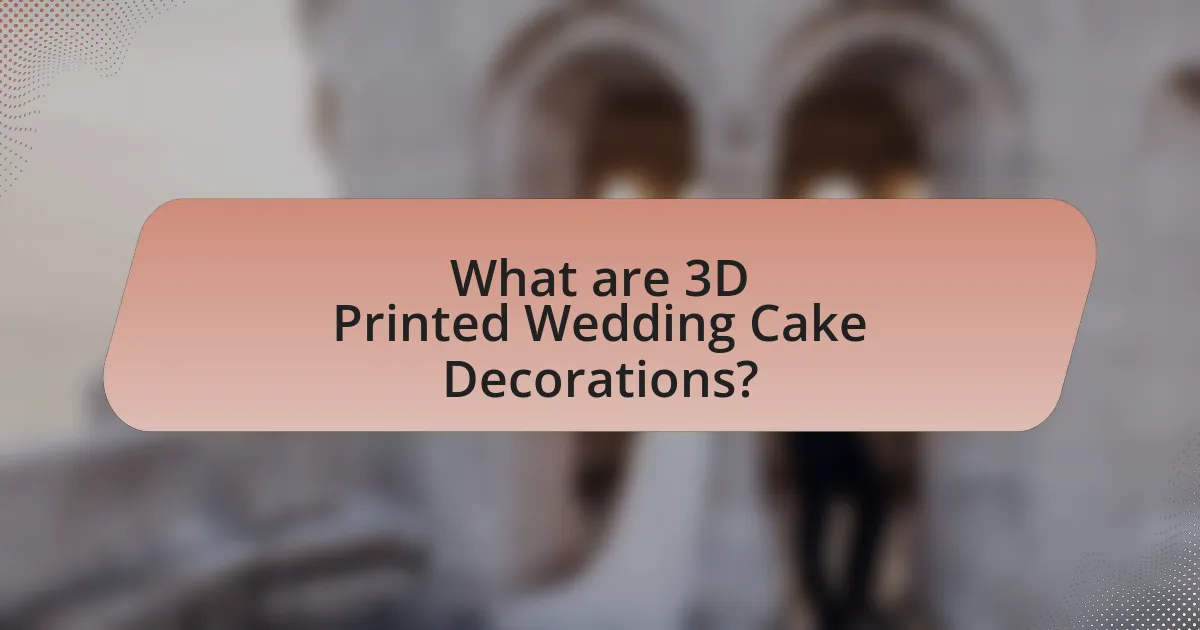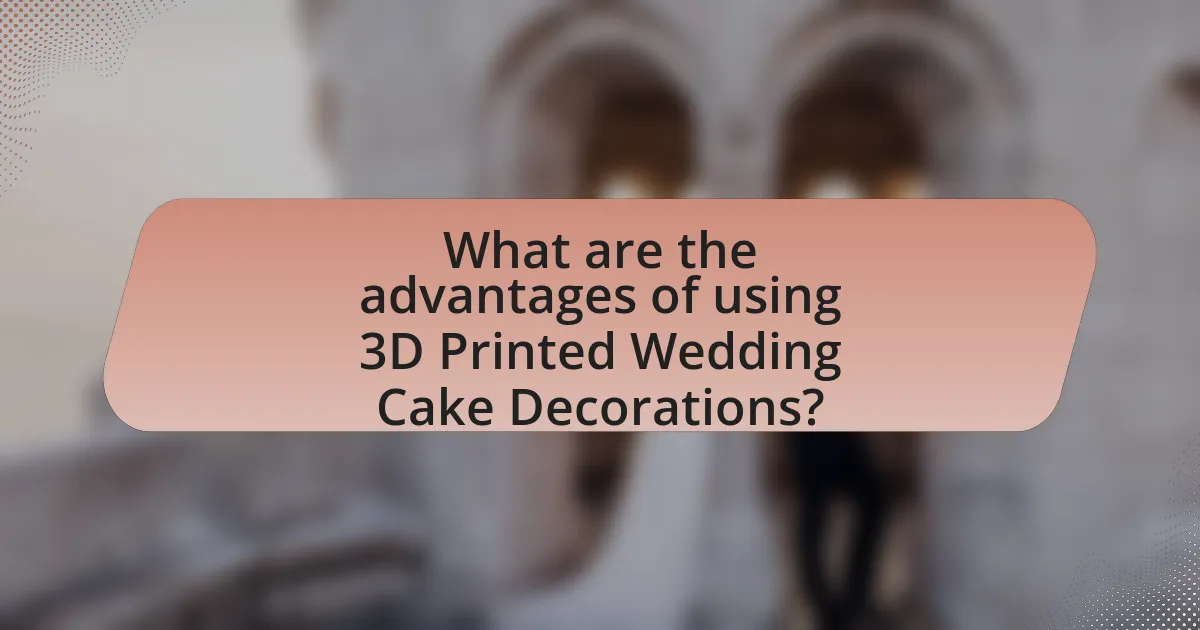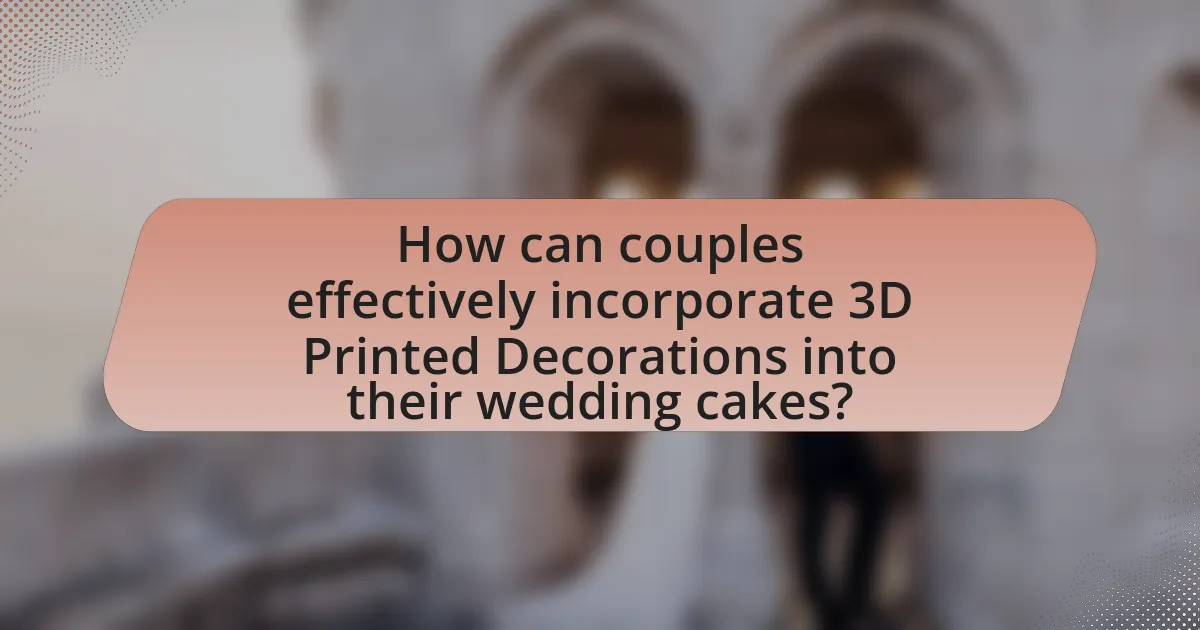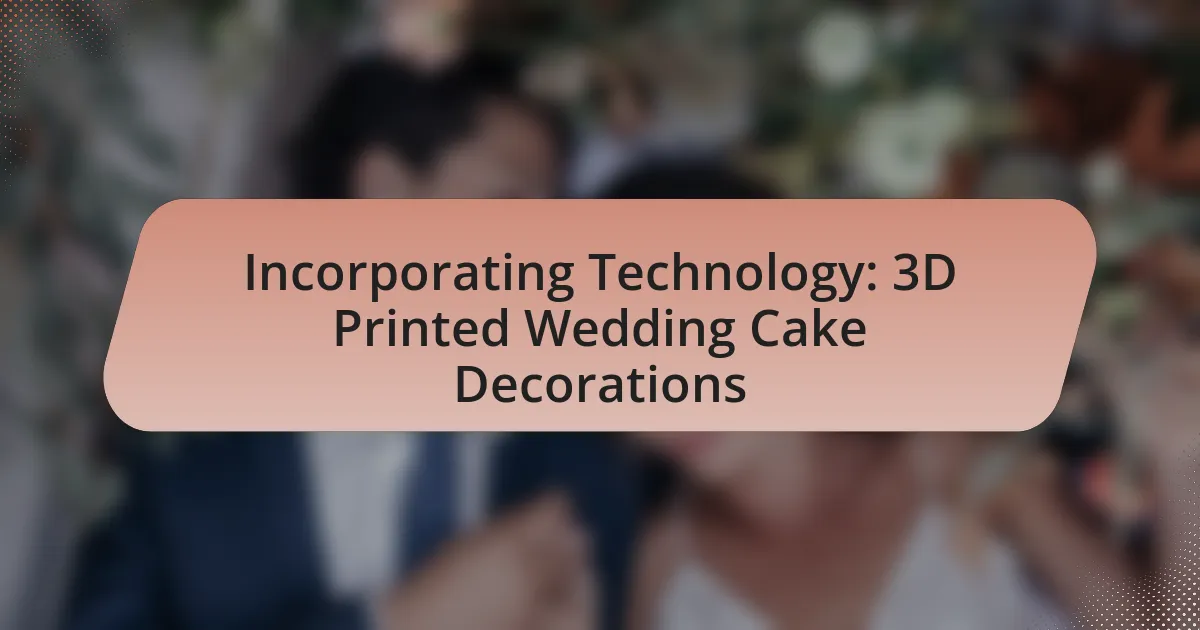3D printed wedding cake decorations are custom-designed embellishments created using advanced 3D printing technology, allowing for intricate designs that enhance the visual appeal of wedding cakes. This article explores the process of creating these decorations, including the technologies and materials used, such as Fused Deposition Modeling (FDM) and food-safe plastics. It also discusses the advantages of customization, precision, and cost-effectiveness that 3D printing offers compared to traditional cake decoration methods. Additionally, the article addresses potential drawbacks, design considerations, and best practices for integrating 3D printed elements into wedding cakes, ensuring a unique and memorable experience for couples.

What are 3D Printed Wedding Cake Decorations?
3D printed wedding cake decorations are custom-designed embellishments created using 3D printing technology to enhance the aesthetic appeal of wedding cakes. These decorations can include intricate designs such as floral patterns, personalized cake toppers, and themed elements that reflect the couple’s style or wedding theme. The use of 3D printing allows for precise detailing and the ability to produce unique designs that may be difficult or impossible to achieve with traditional cake decoration methods.
How are 3D printed decorations created for wedding cakes?
3D printed decorations for wedding cakes are created using a process that involves designing a digital model, which is then printed layer by layer using food-safe materials. The process begins with a 3D modeling software where the desired decoration is designed, ensuring it meets aesthetic and structural requirements. Once the design is finalized, it is converted into a format compatible with a 3D printer.
The 3D printer uses edible materials, such as sugar or chocolate, to construct the decoration, allowing for intricate designs that are difficult to achieve through traditional methods. The printer deposits the material in precise layers, gradually building up the decoration until it is complete. This technology enables bakers to produce customized and detailed cake toppers or embellishments that enhance the overall presentation of wedding cakes.
What technologies are used in 3D printing for cake decorations?
Fused Deposition Modeling (FDM) and Stereolithography (SLA) are the primary technologies used in 3D printing for cake decorations. FDM works by extruding melted food-safe materials, such as chocolate or sugar, layer by layer to create intricate designs. SLA utilizes a light source to cure liquid resin into solid structures, allowing for highly detailed and smooth finishes. Both technologies enable the production of customized and complex cake decorations that enhance the aesthetic appeal of wedding cakes.
What materials are suitable for 3D printed cake decorations?
Suitable materials for 3D printed cake decorations include food-safe plastics such as PLA (polylactic acid) and PETG (glycol-modified polyethylene terephthalate). PLA is biodegradable and commonly used in food applications, while PETG is known for its durability and resistance to moisture. Both materials can be printed with food-safe filaments that meet safety standards for direct contact with food. Additionally, edible materials like sugar or chocolate can be used in specialized 3D printers designed for food, allowing for intricate designs that are safe to consume.
Why are couples choosing 3D printed decorations for their weddings?
Couples are choosing 3D printed decorations for their weddings primarily due to the customization options and unique designs that 3D printing technology offers. This technology allows couples to create personalized decorations that reflect their individual styles and themes, which is increasingly important in modern weddings. For instance, a survey by The Knot in 2022 indicated that 70% of couples prioritize personalization in their wedding planning, making 3D printing an attractive option. Additionally, 3D printed decorations can be produced quickly and cost-effectively, enabling couples to achieve their desired aesthetic without exceeding their budgets.
What unique designs can be achieved with 3D printing?
3D printing can achieve intricate and customized designs that are not possible with traditional cake decoration methods. This technology allows for the creation of detailed, personalized cake toppers, complex geometric patterns, and unique textures that enhance the visual appeal of wedding cakes. For instance, 3D printing enables the production of delicate lace-like structures or themed figurines tailored to the couple’s preferences, which can be precisely crafted to match wedding themes or colors. The ability to use various materials, including edible filaments, further expands the design possibilities, allowing for both aesthetic and functional elements in cake decoration.
How do 3D printed decorations enhance the wedding cake experience?
3D printed decorations enhance the wedding cake experience by providing intricate, customizable designs that reflect the couple’s unique style and theme. These decorations can be tailored to match specific color schemes, motifs, or personal interests, allowing for a level of personalization that traditional cake decorations often cannot achieve. For instance, a study by the University of Southern California highlighted that 3D printing technology allows for the creation of complex shapes and detailed patterns that are not feasible with conventional methods, thus elevating the visual appeal of wedding cakes. This customization not only makes the cake a focal point of the celebration but also contributes to the overall aesthetic and emotional significance of the event.

What are the advantages of using 3D Printed Wedding Cake Decorations?
3D printed wedding cake decorations offer customization, precision, and cost-effectiveness. Customization allows couples to create unique designs that reflect their personal style or wedding theme, which is often difficult to achieve with traditional methods. Precision in 3D printing ensures that intricate details are accurately reproduced, enhancing the overall aesthetic of the cake. Additionally, 3D printing can reduce costs by minimizing material waste and labor time compared to handcrafted decorations. These advantages make 3D printed decorations a popular choice for modern weddings.
How do 3D printed decorations compare to traditional cake decorations?
3D printed decorations offer greater design flexibility and precision compared to traditional cake decorations. While traditional methods often rely on handcrafting techniques that can limit complexity and uniformity, 3D printing allows for intricate designs that can be replicated consistently. For instance, 3D printing can produce detailed geometric shapes and customized designs that would be challenging to achieve by hand. Additionally, 3D printed decorations can be made from food-safe materials, ensuring they are safe for consumption, while traditional decorations may use non-edible components. This technological advancement not only enhances aesthetic appeal but also streamlines the decoration process, making it more efficient for bakers.
What cost benefits do 3D printed decorations offer?
3D printed decorations offer significant cost benefits by reducing material waste and lowering production costs. Traditional manufacturing methods often involve excess material and labor, whereas 3D printing utilizes only the necessary amount of material, which can decrease costs by up to 70% in some cases. Additionally, 3D printing allows for rapid prototyping and customization, eliminating the need for expensive molds and tooling, further enhancing cost efficiency. This technology enables creators to produce intricate designs at a fraction of the cost compared to conventional methods, making it an economically viable option for wedding cake decorations.
How does customization play a role in 3D printed decorations?
Customization is essential in 3D printed decorations as it allows for the creation of unique, personalized designs tailored to individual preferences. This capability enables users to modify shapes, sizes, colors, and intricate details, resulting in decorations that reflect personal styles or themes, particularly in contexts like weddings. For instance, a study by the University of Southern California highlighted that 3D printing technology can produce bespoke cake toppers that align with the couple’s interests, enhancing the overall aesthetic of the wedding cake. This level of personalization not only elevates the visual appeal but also adds sentimental value, making the decorations memorable and significant.
What are the potential drawbacks of using 3D printed decorations?
The potential drawbacks of using 3D printed decorations include limited material options, potential health risks from certain plastics, and aesthetic limitations. Limited material options can restrict the durability and finish of the decorations, as many 3D printing materials may not withstand moisture or heat, which is critical for items like wedding cake decorations. Additionally, some 3D printing materials, such as certain plastics, may release harmful chemicals when heated, posing health risks if they come into contact with food. Aesthetic limitations arise because 3D printed items may lack the intricate details and smooth finishes achievable through traditional decoration methods, potentially affecting the overall visual appeal of the cake.
Are there any limitations in design or material for 3D printed decorations?
Yes, there are limitations in design and material for 3D printed decorations. The design limitations often stem from the capabilities of the 3D printer, which may restrict the complexity of shapes and details that can be achieved. Additionally, certain materials used in 3D printing, such as PLA or ABS plastics, may not be suitable for food contact or may not provide the desired aesthetic finish for decorations. For instance, while PLA is biodegradable and easy to print, it can be less durable and may not withstand high temperatures, making it unsuitable for certain applications. These factors highlight the need for careful consideration of both design intricacies and material properties when creating 3D printed decorations for events like weddings.
How do 3D printed decorations affect the overall cake structure?
3D printed decorations enhance the overall cake structure by providing precise, lightweight, and customizable elements that can be integrated seamlessly. These decorations can be designed to fit specific areas of the cake, ensuring stability and aesthetic appeal without adding significant weight. For instance, studies have shown that using materials like food-safe PLA for 3D printing results in decorations that maintain structural integrity while allowing for intricate designs. This combination of lightweight materials and precise engineering helps prevent structural collapse, ensuring that the cake remains stable during display and serving.

How can couples effectively incorporate 3D Printed Decorations into their wedding cakes?
Couples can effectively incorporate 3D printed decorations into their wedding cakes by designing custom elements that reflect their personal style and wedding theme. Utilizing 3D printing technology allows for intricate designs, such as personalized cake toppers, floral accents, or themed motifs that traditional methods cannot achieve. For instance, a couple can create a unique cake topper featuring their initials or a significant symbol, enhancing the cake’s visual appeal and personal connection. Additionally, 3D printed decorations can be made from food-safe materials, ensuring they are safe for consumption. This innovative approach not only adds a modern touch to the wedding cake but also allows for greater creativity and customization, making the cake a memorable centerpiece of the celebration.
What steps should couples take to design their 3D printed decorations?
Couples should follow a structured process to design their 3D printed decorations, which includes brainstorming ideas, selecting a design software, creating or customizing a 3D model, choosing the appropriate materials, and finally, printing the design. Initially, couples should brainstorm themes and styles that reflect their wedding vision, ensuring the decorations align with their overall aesthetic. Next, they should select user-friendly design software such as Tinkercad or Blender, which allows for both simple and complex designs. After that, couples can either create their own 3D model or customize existing templates available online, ensuring the design fits their specific needs. Choosing the right materials, such as food-safe plastics for cake decorations, is crucial for safety and aesthetics. Finally, couples should utilize a reliable 3D printing service or a personal 3D printer to produce the decorations, ensuring they conduct test prints to verify quality before the final production. This systematic approach ensures that the 3D printed decorations are both unique and suitable for their wedding celebration.
How can couples collaborate with designers for custom decorations?
Couples can collaborate with designers for custom decorations by clearly communicating their vision and preferences, which allows designers to create tailored solutions. This collaboration often involves sharing inspiration, such as images or themes, and discussing specific requirements like colors, styles, and materials. Engaging in regular feedback sessions throughout the design process ensures that the final product aligns with the couple’s expectations. Additionally, utilizing technology, such as 3D modeling software, can enhance this collaboration by providing visual representations of the designs before production, allowing for adjustments and refinements based on the couple’s input.
What considerations should be made regarding cake flavor and decoration compatibility?
Cake flavor and decoration compatibility is crucial for ensuring a harmonious taste experience. When selecting flavors, consider the sweetness and richness of the cake, as these factors influence how well they pair with various decorations. For instance, a rich chocolate cake may be complemented by lighter, less sweet decorations like whipped cream or fruit, while a vanilla cake can handle more elaborate, sweeter decorations such as fondant or buttercream.
Additionally, the texture of the decoration should align with the cake’s flavor profile; for example, crunchy decorations can enhance a moist cake, providing a contrast that elevates the overall experience. Flavor pairings should also be considered; complementary flavors, such as lemon decorations on a vanilla cake, can enhance the overall taste.
Research indicates that flavor compatibility significantly affects consumer satisfaction, with studies showing that well-matched flavors lead to a more enjoyable eating experience. Therefore, careful consideration of flavor and decoration compatibility is essential for creating a successful cake design.
What tips can help ensure successful integration of 3D printed decorations?
To ensure successful integration of 3D printed decorations, it is essential to select materials that are food-safe and compatible with cake decoration. Using FDA-approved filaments, such as PLA or PETG, guarantees safety for edible items. Additionally, proper design considerations, such as ensuring that the decorations are lightweight and securely attached to the cake, enhance stability and aesthetics. Testing the decorations for durability and ease of cleaning before the event further ensures they will withstand handling and display. These practices are supported by industry standards for food safety and design principles in cake decorating, which emphasize the importance of material selection and structural integrity.
How can couples troubleshoot common issues with 3D printed decorations?
Couples can troubleshoot common issues with 3D printed decorations by identifying specific problems such as warping, layer separation, or poor adhesion. For instance, if warping occurs, adjusting the print temperature or using a heated bed can help maintain consistent material properties during printing. If layer separation is evident, ensuring proper nozzle temperature and using the right filament type can improve adhesion between layers. Additionally, couples should regularly calibrate their 3D printer and use high-quality materials to minimize defects. These troubleshooting steps are supported by best practices in 3D printing, which emphasize the importance of printer settings and material quality in achieving successful prints.
What best practices should be followed for maintaining the quality of 3D printed decorations?
To maintain the quality of 3D printed decorations, it is essential to store them in a cool, dry environment away from direct sunlight and humidity. This practice prevents warping and degradation of materials, which can compromise the aesthetic and structural integrity of the decorations. Additionally, regular cleaning with a soft, dry cloth helps remove dust and prevents buildup that can affect appearance. Using protective coatings, such as food-safe sealants for edible decorations, further enhances durability and safety. These methods are supported by material science principles, which indicate that environmental factors significantly influence the longevity and quality of 3D printed objects.
